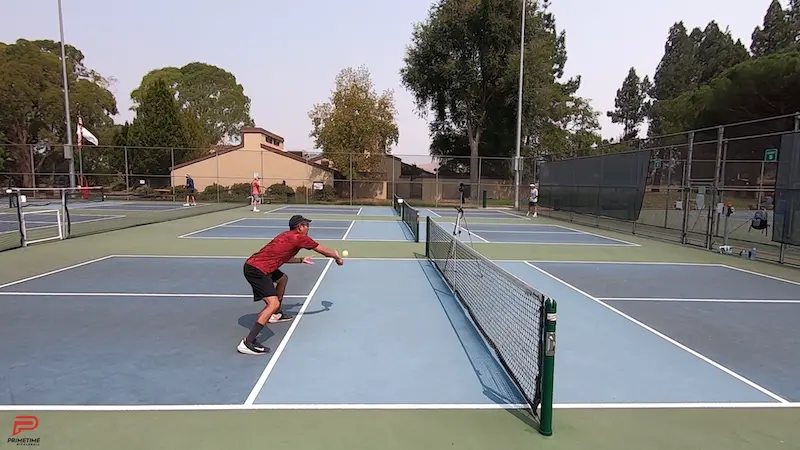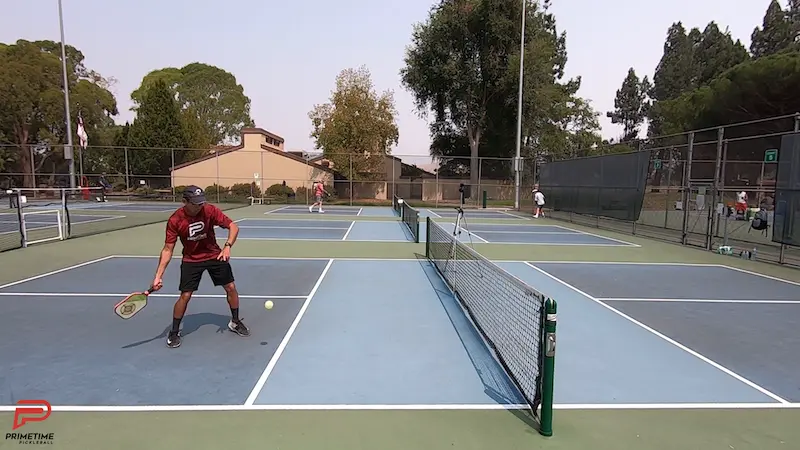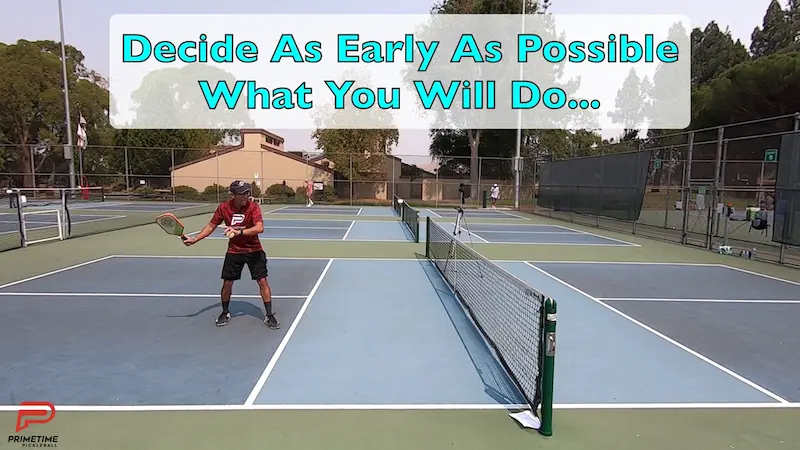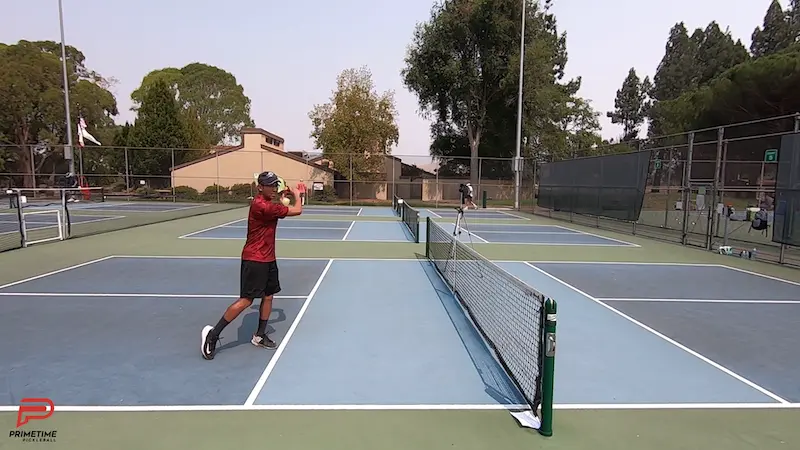Do you want to pin your opponents back at the baseline and keep them from getting to the non-volley zone?
If you do, this blog is just for you.
This blog is about the fourth shot step back drive which is a very efficient shot that players from low levels all the way to pro levels use all the time.
This blog is going to be very helpful to you so let’s dive right in.
Before we get started on the details about how to hit this shot let’s set the stage on when it applies.
We’re going to cover a specific type of fourth shot.
The fourth shot is always struck by the returning team in a pickleball point.
The serve is the first shot. The return is the second shot following which the returning team advances to the net. Next comes the third shot which is always struck by the serving team.
In this particular instance we are assuming that the third shot is a drop and that is a very common scenario in pickleball.
On the fourth shot, we often recommend that you take this shot as a volley because it takes time away from your opponents when you don’t let the ball bounce. This will give them less time to get all the way up to the non-volley zone line after their third shot.

By doing this you will often be able to force them to hit their next shot, which is the fifth shot, from the transition zone or even further back. This is good for you since at that particular moment of the point you are winning the ground war because you are up at the net and they are further back.
However, there are some key times, under particular conditions, that you may want to consider a step back drive on the fourth shot because it creates particular advantages for your team to do so.
We’ll cover those conditions and advantages now.
Number one, if you see that their third shot drop has a relatively high arc but you won’t be able to reach it out of the air with a contact point above the net then it may be a good idea to let it bounce. Chances are it will bounce relatively high and just kind of sit there nicely for you to hit more offensively than you could with a volley dink.
The upside of the opportunity to hit more offensively than you could with a dink volley can often outweigh the downside of giving your opponents a little extra time.
They will likely not even take advantage of closing in on the net with the extra time they have because they see their shot is high and could bounce in an attackable way for you.
Number two, if you see that the ball is coming in with a relatively flat trajectory as opposed to high and it’s going to land deeper in the kitchen right near your feet. You’d have to hit it as a dink volley with a very low contact point or even as a half volley so at this time it could be to your advantage to scoot back quickly off the line and let that ball bounce in order to get a higher contact point after the bounce.

Even though the contact point will be much further back it’s higher and the net is no longer right in your face as it would be with a low contact dink volley or half volley up at the line.
You’ll be able to hit the step back shot more offensively especially if you have a good roll shot, also known as a topspin shot, in your arsenal.
This shot will be more beneficial to you as opposed to if you were standing up at the line and volleying this ball. Because you’re stepping back and you’re taking this ball at a high point and you’re contacting it higher than it would be if you were volleying it this is going to allow you to create a lot of topspin, hit a drive, and for that ball to dip down at your opponent’s feet.
Now that you know the key advantages, we’re going to go through the breakdown of this shot.
The first thing that you want to know about this is you have to have early preparation.

Let’s say you’re at the non-volley zone line and you notice that your opponent is going to hit that drop. You always want to be ready for the drive but in this case you see that they’re going to hit the drop so that you know it’s a possibility that they could hit it really well and you’re going to be contacting the ball low.
So, as you see them hit that drop you’re going to take the step back.
You’ll just step back and prepare and put your paddle back to get ready for the drive. You’ll drop your right foot back for a right-hander.
Tip number two is about the stance. Typically when you are at the net you are in an open stance. Your chest is facing the net and it’s parallel with the net.
But, because you are stepping back, dropping your paddle back and your right foot is back you are going to naturally drop into a closed stance or a semi-open stance. Either is good.
You’re loading your back leg and you have your knees bent and ready to hit that forward drive.
Tip number three is your swing motion.
You are setting up to hit a top spin, with a medium to to fast pace drive, at your opponent.
As you drop your paddle, by your right hip or your right knee, you’re going to be swinging upwards. This is what creates that topspin motion.
You’re going to swing through up to your left shoulder.

You are going to be in great position as you drop back and you let that ball come to its peak. Then you’re going to hit that shot.
The fourth thing that we want to mention is the target of your shot when you’re hitting the ball.
Remember your opponent is hitting their third shot drop and coming in.
So, as you step back, you’re going to be getting ready for that ball to bounce at the peak and you’re also keeping an eye on where your opponent is on the court.
Depending where their feet are, that’s kind of where you’re going to try to hit the ball. Or a even a foot or two in front of their feet.
You wan to hit anywhere where their feet are because they’re going to have to stop and split step as you’re hitting this ball to wherever they are coming through that transition zone.
What this is going to do is that it’s going to force them to have a low contact point.
So you’re going to prepare early, drop your paddle back, load your back leg getting ready for the drive in a semi-closed or closed stance. And then, you’re going to swing with that low to high motion pushing up on the ball, which creates that top spin, and as your opponent is coming in you’re aiming at their feet.
This is a shot that is really going to keep your opponents pinned back at least a little bit longer as they try to work their way through that transition zone.
If you’re at the net and lean in and try to take every ball out of the air, that’s really good. But, if your opponents are hitting great third shot drops that are descending into your non-volley zone and you constantly have to hit up on the ball it’s going to be really hard for you to hit an offensive shot. So, this is a way to take what would have been a low contact ball and defensive ball in to a more offensive ball.